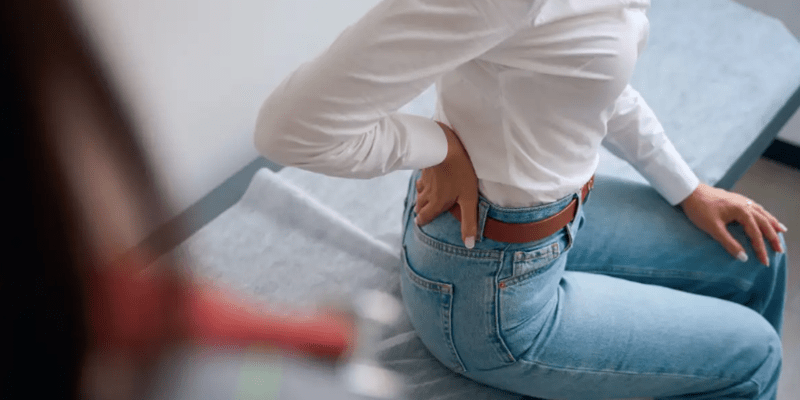Noticing what drives pain is not satisfying, but it can be helpful. Recording the symptoms you encounter can help you track patterns and reduce inflammation in lower back.
If youve ever been diagnosed with acute back pain, you know the signs: immobility, primarily upon waking in the morning, distress, and reduced extent of motion of the backbone.
But what you perhaps do not know is that these signs are also related to several inflammatory arthritis conditions, comprising ankylosing spondylitis (AS), enteropathic arthropathy, psoriatic, reactive arthritis, and juvenile idiopathic arthritis.
To figure out if you have inflammatory back pain or one of these other arthritis conditions, jointly known as spondyloarthropathies, you and your physician may need to trace your symptoms over an extensive period to discover if or how they evolve or progress.
No more talk; lets explore how keeping a symptom diary can help you manage inflammatory back pain!
Managing Inflammatory Back Pain Importance of Symptom Diary

This article will show you how tracking symptoms will help you determine the causes and solutions to your backbone problems.
Helps You Know The Exact Condition
Keeping a symptom diary can help you determine whether you have inflammatory back pain or some other sort of medical condition.
Like other arthritis conditions, inflammatory back pain, which is also known as spondyloarthritis, is, in fact, a form of allergic, infectious arthritis.
This indicates the discomfort and pain you feel with IBP stems from the cells of your antibodies invading one another in error, a process that causes inflammation.
With inflammatory back pain, distress is typically limited to the buttocks and lower back. It hits people before age 40, and pain persists for 3 or more monthsindividuals with back pain commonly report morning stiffness that gets better with mobility or exercise.
As you track your signs in your journal, your physician will be capable of determining if they match lower back inflammation symptoms or are traceable to something else.
Helps To Report Progress to Another Inflammatory Condition

Another reason to keep a Symptom diary in back pain treatment is that it is essential when you have chronic back pain to avoid IBP getting into ankylosing spondylitis or another spondyloarthropathy, which can give rise to other health complications.
Its been calculated that 40 percent of individuals with IBP will get ankylosing spondylitis (AS). Documenting what physicians call extra-articular symptoms is essential.
Because severe back pain can get into a worse form of ankylosing spondylitis, its critical to note down symptoms like chronic diarrhea or psoriasis-like symptoms; skin rashes, blood in your stools, or indigestion; and eye inflammation signs like pain, redness, and blurry vision.
Spondyloarthropathies like ankylosing spondylitis are indeed a range of conditions that can impact different body organs, including the eyes, joints, bowels, and skin, among others, with severe long-term consequences.
For instance, eye inflammation can give rise to vision changes and sightlessness if not correctly diagnosed and handled. Thats why its essential to be aware of extra-articular indications of inflammatory backache and be on the lookout for hearing them. Only a diary can aid you in doing that.
Things Track in Your IBP Symptom Diary
Its important to get an idea about what to pen down in your diary. Every time your back pain hits, observe the condition mentioned below and write it down in your journal. Take into account the following notes:
- Any joint stiffness
- Pain duration and intensity
- When and how the pain lessens
- The date and time you noticed your symptoms
- What activity were you doing at the moment the stiffness or pain started
Effective inflammatory back pain treatment should reduce the pain level significantly, improve morning immobility or even remove it, and enhance general functionality.
Your physician wouldnt suppose you to carry on to waking up in the middle of the darkness because of severe back pain. To help them treat your disease efficiently, you must provide them with every minor detail.
Recording stuff appropriately by answering questions like this: Is the distress ongoing daily or 2-3 days a week? Whats the time duration of stiffness in the morning? It must be noted that it is down in terms of symptom intensity.
You need to help your doctor comprehend the harshness of your pain or stiffness. An easy zero to ten range works well, with zero being relieved or no stiffness and 10 being acute pain or immobility.
What Details Are Important To Include In Your Diary?

All in all, you should also incorporate any additional information that can assist in explaining the symptoms you encounter in greater detail.
As an illustration, was the distress or pain on the right or left side of your back? Was it acute or bearable? Your exercise habits are also worth noting.
Characterize the type of workouts youre doing and when you are doing them (how often and what time of day), and show whether your physical exercise reduces your symptoms at all.
Finally, theres no proper direction to maintain a symptom diary, but the general principle is that the more data you track, the better.
Check your diary both by yourself and with your health professional or therapist. It can be a helpful way to recall what helps and what doesnt in managing your active back pain.
Final Thoughts
Inflammatory back pain is a stressful and frustrating condition that affects your daily functioning. Incorporating every way that helps you treat it well must adopted by yourself.
One such tactic is maintaining a symptom diary in back pain treatment to track the exact details of symptoms, pain duration, and remedies that relieve pain.
You must consider noting every single detail, along with the appearance of any new symptoms. This will help your physician to diagnose the issue and the right treatment.





